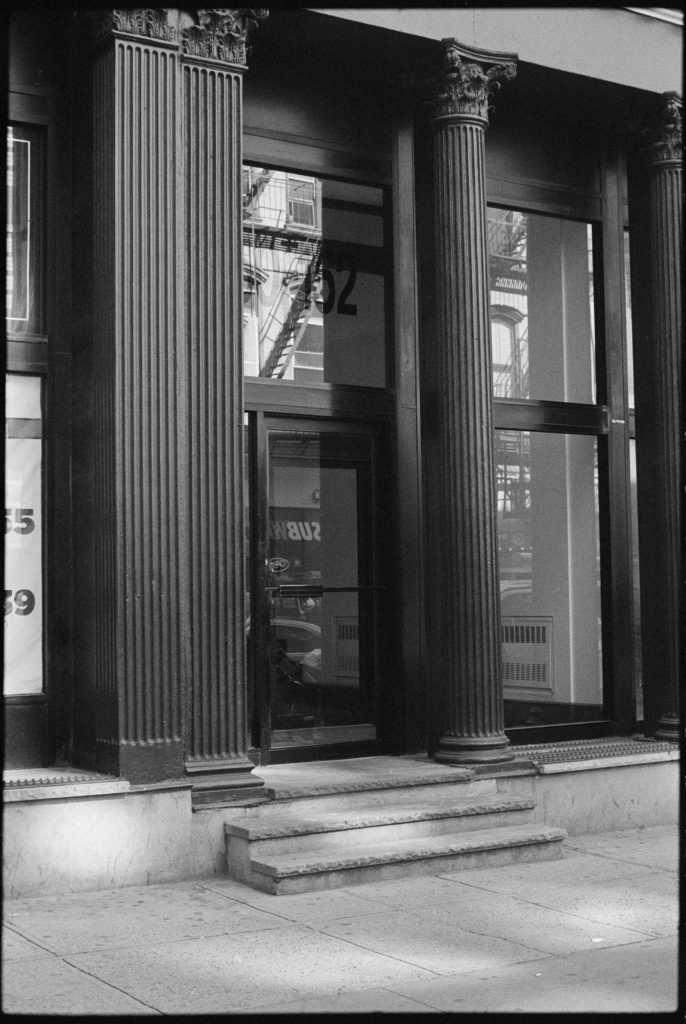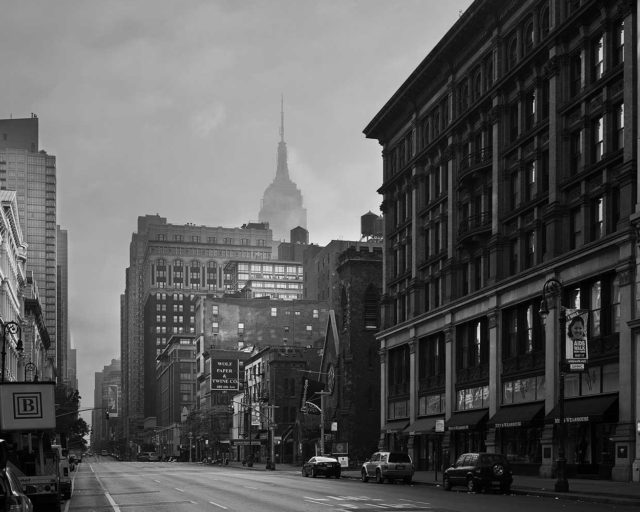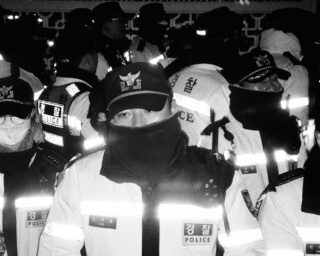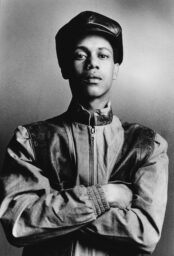Zoe Leonard, Downtown (for Douglas), 2016
Zoe Leonard made the twenty-one photographs that compose her series Downtown (for Douglas) on the occasion of her friend, the late art critic and curator Douglas Crimp’s much-loved publication Before Pictures (2016). Leonard’s photographs depict the various residences and neighborhoods Crimp called his own during his first decade in New York City—between 1967, the year he moved from his home state of Idaho to an apartment in Manhattan’s Spanish Harlem, and 1976, the year before he curated the groundbreaking Pictures exhibition, moving downtown into a loft apartment in the landmark Bennett Building, “pretending,” he writes in the book, “to be an office tenant.”
Leonard’s series appears as double-page spreads before each discrete section of Crimp’s book, as would establishing shots in the sequence of frames that constitute the narrative flow of film, introducing Crimp’s readers to the writer by taking us to his doorstep—where Crimp would go before and after work, or ballet class, or a night dancing at Crisco Disco or the Cock Ring. If being queer, as Crimp defines in the preface, “is a matter of a world you inhabit, not something you simply are,” then we might read Leonard’s unpeopled, site-specific photographs as queer, in that they only indirectly suggest the various possibilities of what they define: not the sex, for instance, but the temporality of fantasy that leads up to it—the erotic activity we could call “waiting.”

One image depicts a waiting area near a turnstile in Fulton Street station (a central transit hub in Manhattan’s Financial District, recently refashioned as a food hall and mini-mall). Leonard provides a layered composite of surfaces—grimy tiles, placards, and serif fonts; light fixtures and floors—emblematic to the subway system’s design and the elements of our peripheral attention that are likely to linger in the short-term memory of an actively commuting New Yorker, as Crimp once was. In framing this leitmotif, Leonard’s photograph asks the viewer to reinterpret the principles that organize our sense of the familiar. I find something similar at work in Crimp’s memoir, which resurfaces primary documents from the writer’s past—for example, a “cringe-worthy” notation from a Moroccan cookbook he cowrote, or the lengthy excerpts of art criticism reproduced across the volume—without too much hand-holding. As in Leonard’s photograph, Crimp captures the amalgam of discourses imminent to the emergence of “downtown” as it gained purchase as a cultural touchstone. What did downtown mean before 1977? What does it mean now—and for whom?
In her 4Columns review of Survey, Leonard’s 2018 retrospective at New York’s Whitney Museum of American Art, the critic Johanna Fateman points out the “poetic measure of time” one may glean from Leonard’s sculptural works, as from her photographs; their framing of the quotidian having the powerful effect, Fateman writes, of an “impersonal particularity.” The photographs in Downtown (for Douglas), for example—of the exteriors of apartment buildings and interiors of subway stations—are all of spaces that are public; their crisp registration in Leonard’s photographs details the striking features of the banal spaces we share. I’m reminded of fellow downtowner Joe Brainard’s incantatory memoir from the same era, I Remember (1975), in which a procedural conceit (to reconstruct a memory in writing starting with the phrase “I remember”) is used to catalogue impressions, encounters, and misapprehensions. Personality is sieved out as pithy insight or charm, and readers get a sense of the various social systems to which Brainard belonged.“[I Remember] is about everybody else as much as it is about me,” writes Brainard in a letter to the poet Anne Waldman. “And that pleases me. I mean, I feel like I am everybody. And it’s a nice feeling. It won’t last. But I am enjoying it while I can.”

As part of Before Pictures: New York City 1967–1977 at Galerie Buccholz in New York, curated by Crimp in 2016, Leonard’s Downtown prints hung at eye level in the front corridor alongside photos from Alvin Baltrop’s striking piers series and archival prints made for George Balanchine’s production of Igor Stravinsky’s Agon (1957). The only contemporary artist included in the show, Leonard’s images of New York produced, if memory serves, a kind of strobing effect. When hung in a row, the dark canals of the subway stations interspersed with reflective abstractions that appear in the windows of Crimp’s homes (in one window is the reflection of a Subway fast-food restaurant) generate a visual equivalent to the glamorous nightlife Crimp writes about.
Looking at Leonard’s photographs now, more than four harrowing years after this exhibition, they seem to ask other questions about how mobility works within, and beyond, the art world. I’ve always read Before Pictures as a book that is not only about jobs but also the kinds of access and mobility—both geographic and social—a job in the arts afforded one specific writer. But what happens next?

All photographs courtesy the artist; Galerie Capitain, Cologne; and Hauser & Wirth, New York
Leonard’s black-and-white images of empty subway stations reflect an underfunded and mismanaged municipal institution whose ridership dropped catastrophically in the outset of the COVID-19 pandemic in spring 2020. Its passengers were essential workers only, for the first few months—until the summer came, and the George Floyd uprisings found the city’s populous rioting on foot, across the streets of every borough; we learned how to move again. As the artist and writer Hannah Black wrote in her adieu to 2020 for Artforum, “A riot can’t resurrect the dead, but it can resurrect the dead spaces of cities.” New York City had, meanwhile, responded with perverse enthusiasm to the conditions brought about by the public health crisis, repopulating the vacant subways with a battery of newly hired, idling, armed police officers to persecute the thousands of New Yorkers left homeless by their attempt to survive winter in a pandemic. I see in Leonard’s images the curious, uncompromising qualifier one must accept if one wants to survive in America: get to work, or else.
Read more about New York City in Aperture, issue 242, “New York.”



























